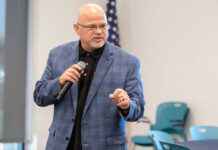
inmaricopa.com runs, on a regular basis, opinion pieces submitted by community members. The following article is the opinion of the author, and does not necessarily reflect the views of inmaricopa.com.
“I know a bank where the wild thyme blows…with sweet musk-roses, and with eglantine: A Midsummer Night’s Dream – William Shakespeare
Willie-the-Shake, as my 12th-grade English teacher amusingly called him, was not referring to sweet cow dung or the flatus of cows, when he wrote his immortal words. For him, it was probably the romantic smell of love in the air. But, a bag of sweet-smelling thyme, countryside grasses and flowers, worn around the neck, might temporarily reduce the Maricopa smell and be a saving grace for our residents’ nostrils, for which many have sensitivity to our local aroma.
According to a BBC publication in January 2002, “Cow feed researchers smell success,” the accelerated awareness of aromatic plant oils in cattle feed could make cows less flatulent, their dung smell sweeter, and could create a “safe green alternative” to existing additives such as antibiotics.
That as it may be, those who do not live near a Concentrated Animal Feeding Operations (CAFO) might think all this “just a farm smell” stuff is a bit overdone, never considering any adverse health effects. Frequent smelling can make a believer, especially when a toxic emission from such a concentration of animal waste is perceived to be making you and your family sick; it really stinks. There are microbial solutions to the manure oder, but they are very costly.
Before drug stores and grocery stores, there was the land. For decades, Maricopa’s agricultural/farming community was the driving force for balancing the elements of its sustainability and must continue to do so. Is it economical? Is it renewable? Is it sustainable? You bet!
For decades, our Maricopa community has had successful and sustainable livestock and agricultural businesses. Livestock and agriculture businesses are interdependent on one another. For example, one local Maricopa business, Scotts Hyponex, which is known for their organic products like Miracle-Gro and Scotts Turf Builder, utilize manure from their neighbors’ cattle for their turf and mulch products.
Hogenes Farms supply the alfalfa and grain for their own dairy cattle and in turn use their cattle’s manure to fertilize their alfalfa and grain crops. Another Maricopa business, Pinal Energy, is providing a byproduct of their ethanol process for a food product to feed their neighbor’s cattle at Pinal Feeding.
Val Whitehead, who works with the Ak-Chin Indian Community and operates his own 520-acre farm, claims that for every ton of feed he supplies the Withrow Dairy, he must take back a ton of manure. The Ak-Chin Indian Community mixes the chicken manure from Hickman farms with local cow manure and “gin trash” to make their own compost for their crops as well.
Livestock has always produced one of the most sustainable and sensible energy sources. Manure continues to be used by farmers for their crops. Everyone, even the deprived city dweller, knows that cow dung makes superb fertilizer.
One real solution to the “smells of Maricopa” is utilizing the methane gas and/or the manure for energy. A recent Arizona Republic article (Feb. 11, 2009, pg. A2), discussed three new electric power plants in North Carolina that are being built utilizing chicken and turkey feces. One of the power plants will open in 2012 and employ 100 people.
Another entrepreneurial opportunity for cow dung is making mud bricks for houses; lining floors and walls, in particular since it makes for cheap and good thermal insulation; fuel for cooking food and heating and insect repellent.
Farmers will be looking to go further beyond the naturally recurring cycles by forming a loop between energy sources and resources with a view to growing “energy crops.” One thing is evident: reliable biomass energy fuels (wood, crops, manure and some garbage) is being taken more seriously now and will be getting the funding it so richly deserves. Unlike fossil fuel use, “if we grow as much new biomass as we burn in biofuels, the carbon in the atmosphere will remain in equilibrium (Green Empowerment).”
As long as people consume meat and dairy, there are going to be feed lots, dairies and dust. According to Bill McKibben, author of “Deep Economy: The Wealth of Communities and the Durable Future,” we need to keep our local farms and agriculture for the sustainability of our future. Maricopa farming and agricultural businesses have created a sustainable environment in our community for many years. Instead of chasing them away, let’s look for solutions that further help our community’s sustainability by creating new, local “green” industries and jobs.
All of our Maricopa residents – city dwellers and farmers – must reconnect with each other through relationships of integrity and empathy. We cannot stop what nature decrees, but we can cooperatively find economical, practical and sensible ways to reduce the impact of nuisances and unpleasantries.
The potential probabilities and possibilities for regenerative agriculture mean dealing with cow and particulate emissions. It is not a “blame game,” but a grave matter that requires mutual attention.
Gina D’Abella, Founder, Environmental Concerns Organization, Inc., contributed to this article.










![Alleged car thief released without charges Phoenix police stop a stolen vehicle on April 20, 2024. [Facebook]](https://www.inmaricopa.com/wp-content/uploads/2024/04/IMG_5040-218x150.jpg)




![City gave new manager big low-interest home loan City Manager Ben Bitter speaks during a Chamber of Commerce event at Global Water Resources on April 11, 2024. Bitter discussed the current state of economic development in Maricopa, as well as hinting at lowering property tax rates again. [Monica D. Spencer]](https://www.inmaricopa.com/wp-content/uploads/2024/04/spencer-041124-ben-bitter-chamber-property-taxes-web-100x70.jpg)